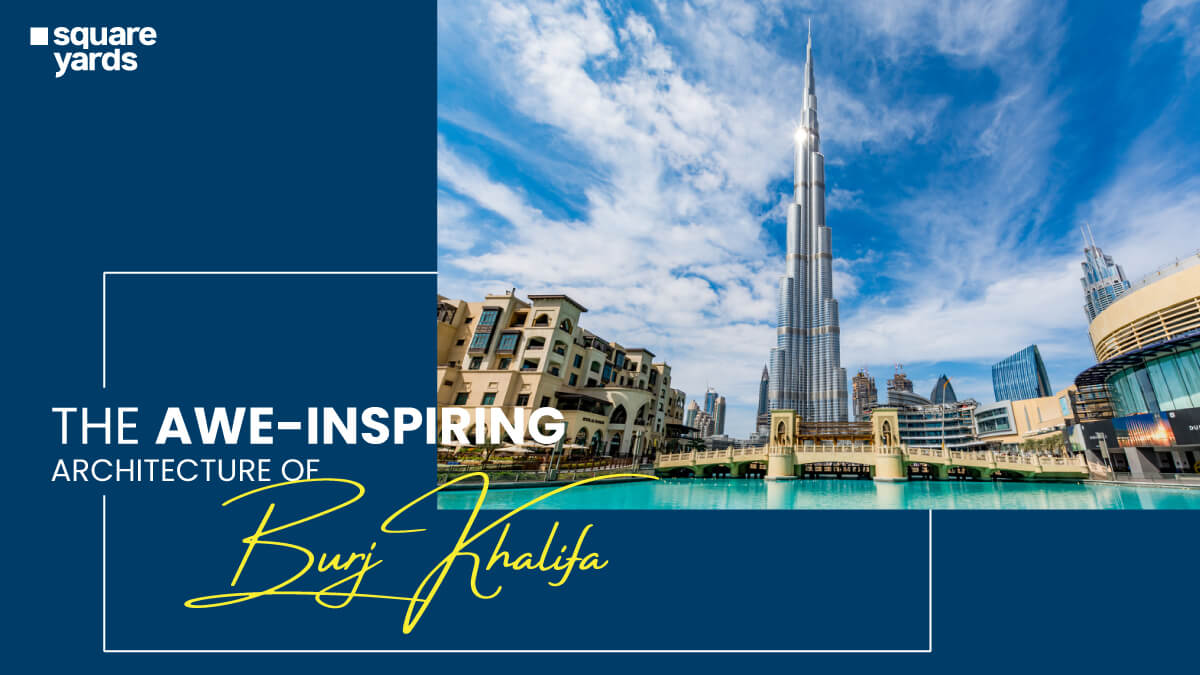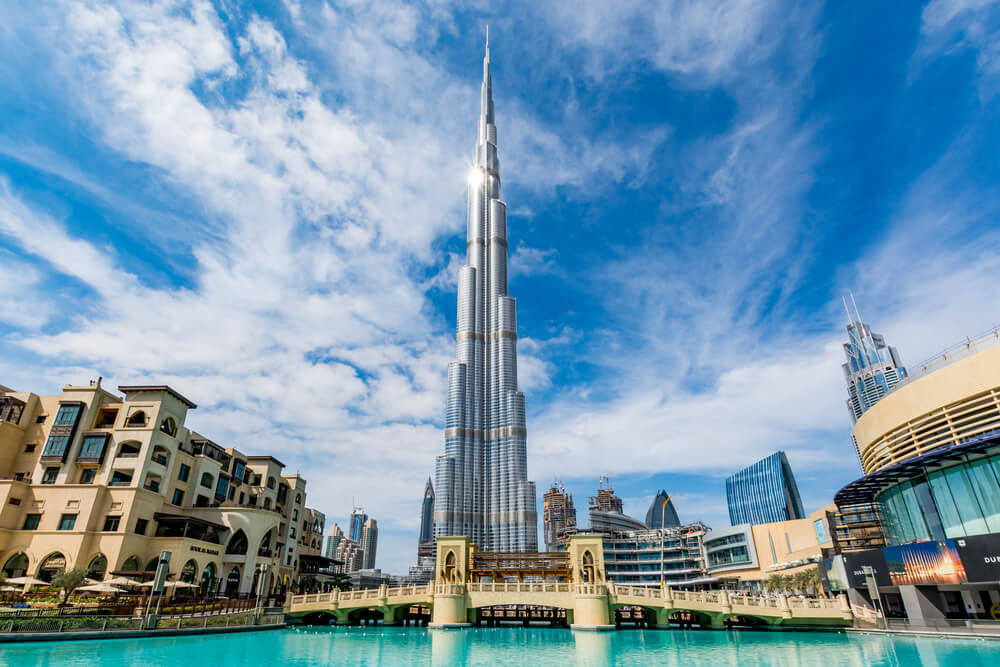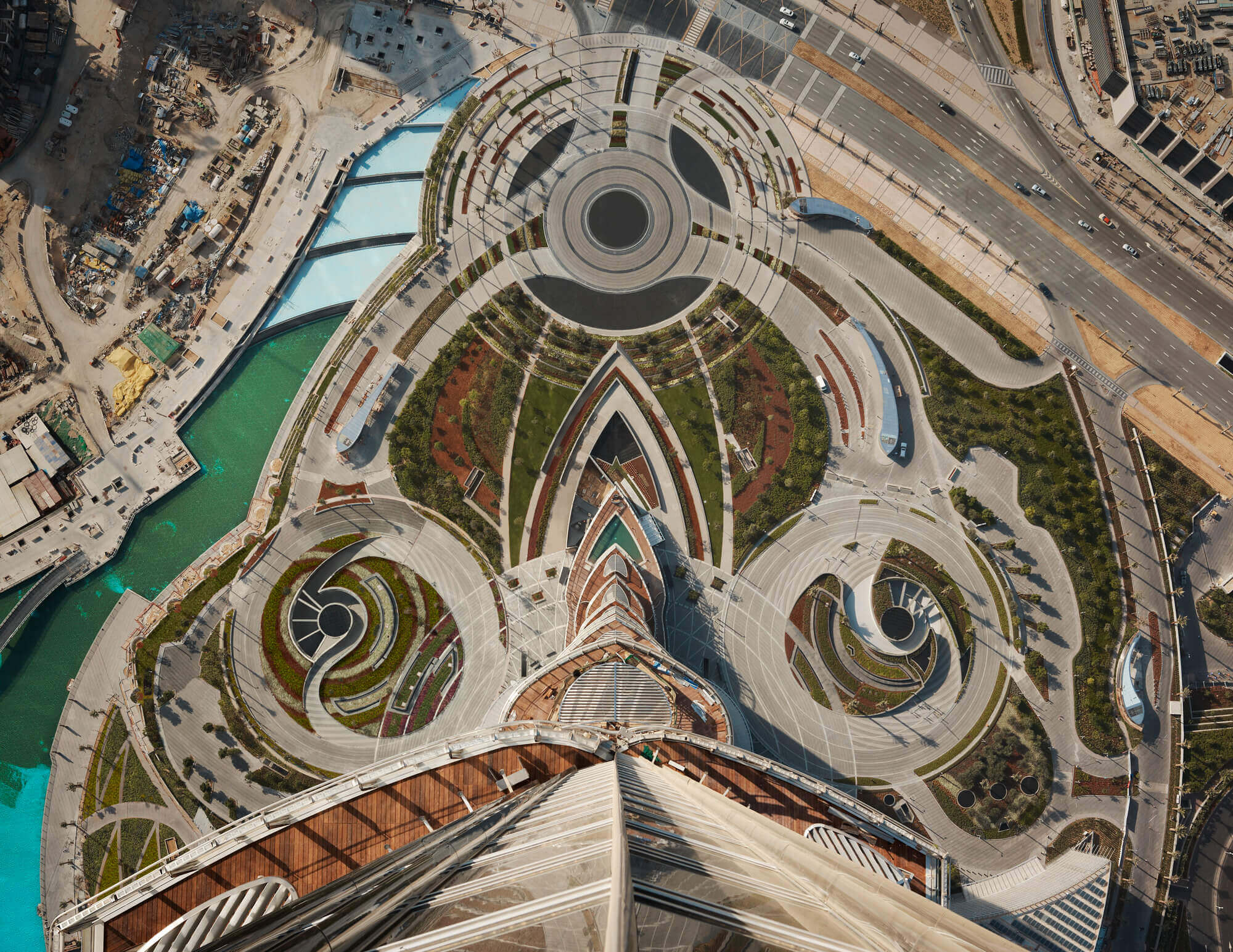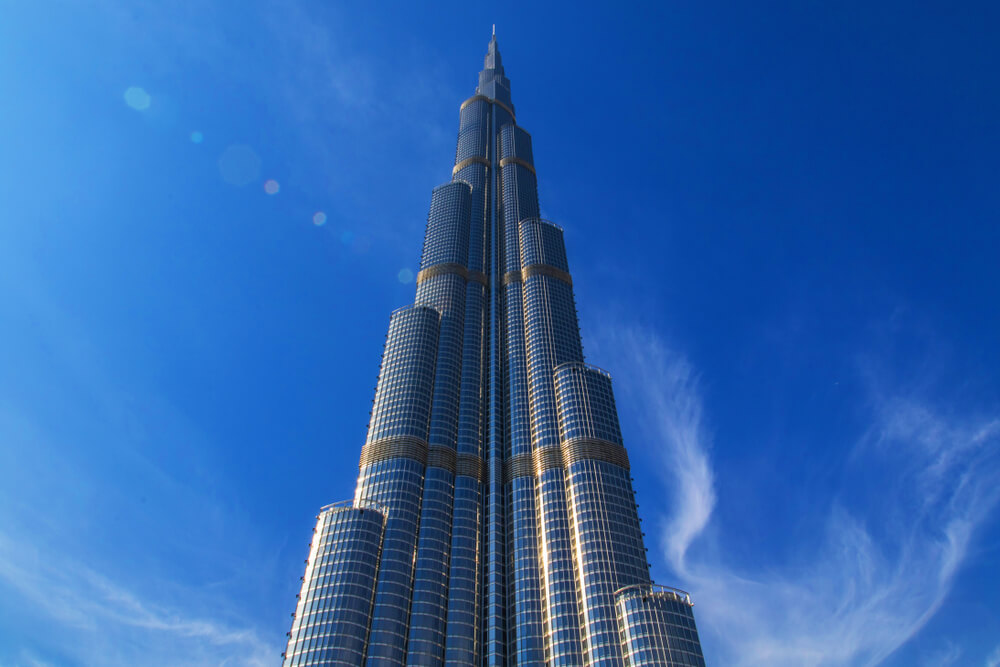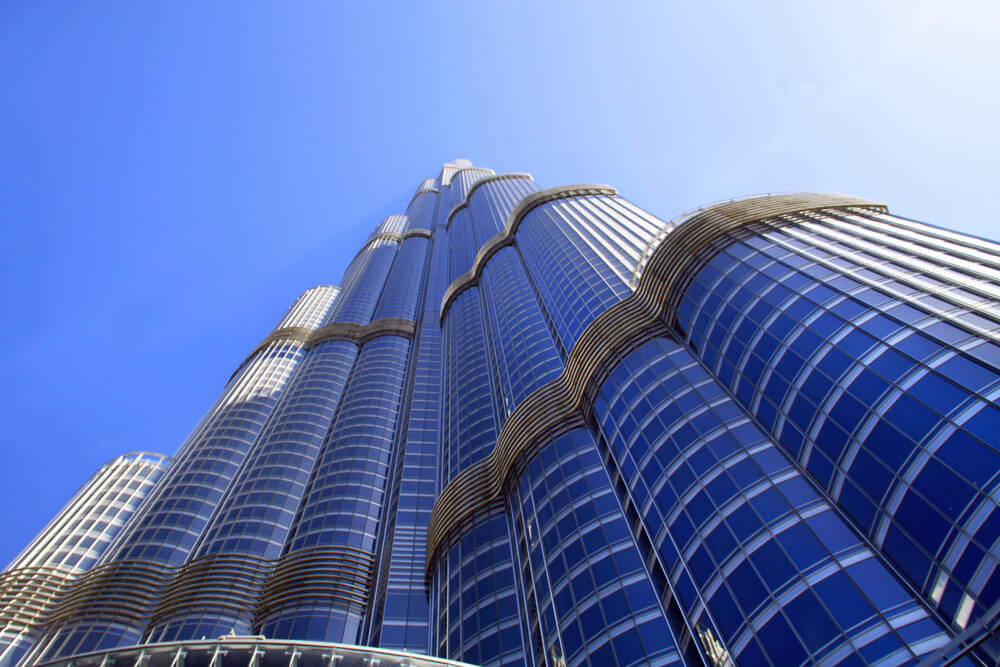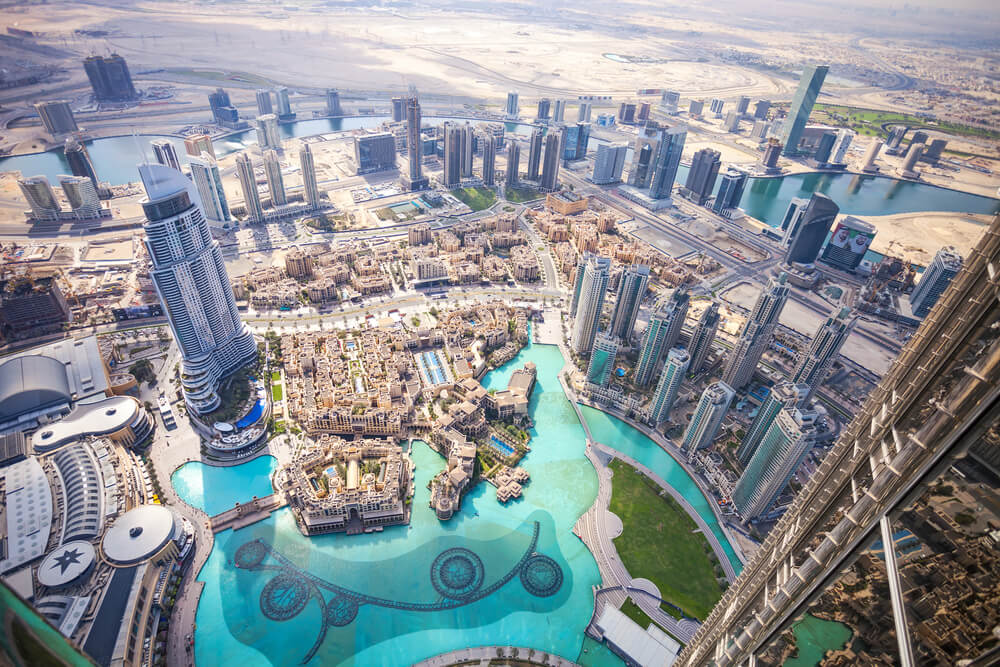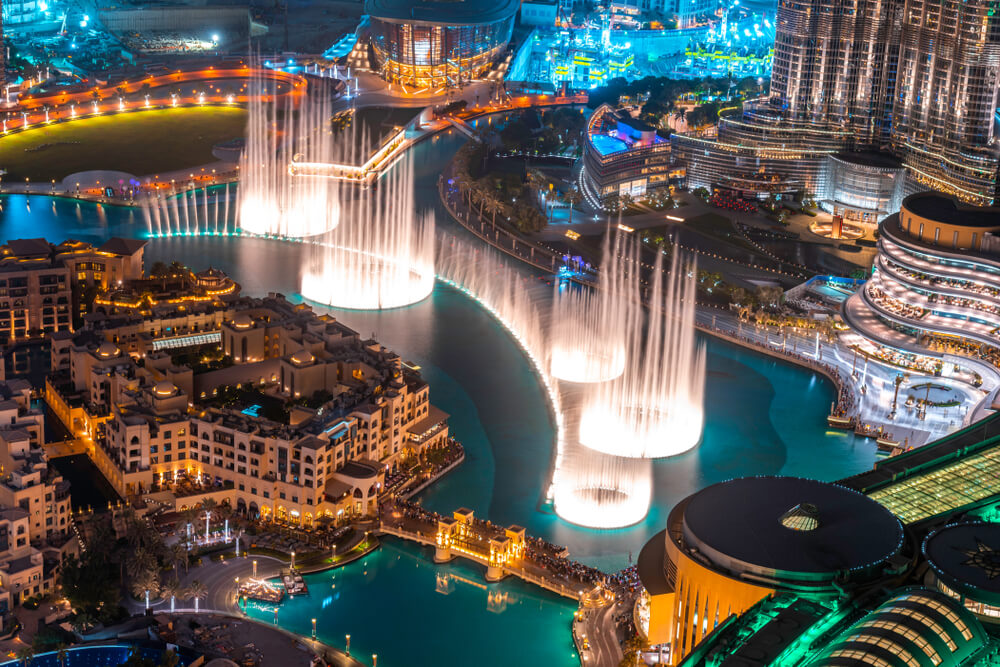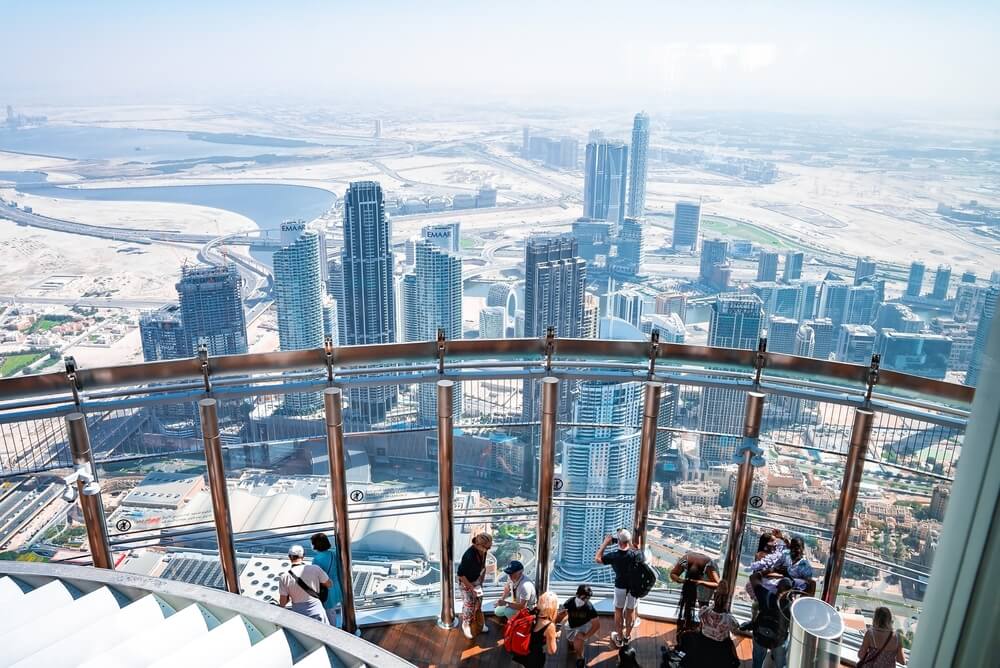In a city known for its dizzying super towers, soaring at a height of 828 meters, the undisputed star of the Dubai skyline is Burj Khalifa – the world’s tallest building. The spiralling tower’s overall design is inspired by the geometries of a regional desert flower and the patterning systems enveloped in Islamic architecture.
Burj Khalifa, Dubai was designed by the architectural firm Skidmore, Owings & Merril (SOM), known for their designs for the Willis Tower (formerly the Sears Tower) and the new One World Trade Center in New York. The design for the Burj Khalifa combines traditional architectural elements with cutting-edge technology to achieve high performance in an extreme desert climate.
Burj Khalifa, Dubai is the epitome of luxury. In the building, you’ll find the second Armani Hotel in the world. It also houses the world’s highest restaurant – the Atmosphere on level 122, for fine dining looking at the city skyline from a height of 441 meters.
Burj Khalifa, Dubai – The World’s Tallest Building
The Burj Khalifa, Dubai is not only the tallest structure in the world, but has also snagged a clutch of other bragging rights. These include the maximum number of records and awards to its name- tallest freestanding structure in the world, highest outdoor observation deck in the world, elevator with the longest travel distance in the world, Best Building 10-Year Award, Global Icon Award, Council on Tall Buildings and Urban Habitat (CTBUH), and many more.
The tallest building in the world has emerged as the second-best location in the world to catch a sunset and the 11th best to see the sunrise.
-
Inspiration from the Flower
The design of the tower is drawn from the shape of the Hymenocallis flower or commonly known as the ‘Spider Lily’. Architect Adrian Smith abstracted the design from six petals of a flower to three, and this forms the basis of the design layout throughout the skyscraper. The central core emerges at the top and culminates in a sculpted spire that measures over 200 m in height, securing Burj Khalifa’s position as the world’s tallest structure.
-
An Engineering Maestro
SOM’s engineers developed innovative strategies to meet the unique challenges of a skyscraper. The simple Y-shaped plan reduces wind forces and fosters constructability. The indigenous design and impressive construction are feasts for architectural lovers. The structural system can be described as a “buttressed core”. Each wing of the tower, with its own high-performance concrete core and perimeter columns, buttresses the others via a six-sided central core or hexagonal hub. Therefore, the result is a tower that is stiff laterally and torsionally. Designers applied a rigorous geometry to the Burj Khalifa that aligned all the common central core and column elements to form the insane structure.
Fun Fact –
Do you know how much concrete was used in making this structure?
The combined weight of one million elephants would be equal to the weight of the concrete used approx. 110,000 tons of concrete and 55,000 of steel rebar went into making this massive building.
-
Stepped Design that ‘Confuses the Wind’
The world’s tallest building, Burj Khalifa’s stepped design with 27 setbacks or tiers spiralling up its height is not only aesthetically elegant but also plays a vital role in reducing the wind forces on the tower as it was a quite challenge when building a skyscraper of this size.
The setbacks are organised, in conjunction with the tower’s grid, such that the building stepping is accomplished by aligning columns above with walls below to provide a smooth load path. These setbacks have an edge of providing a different width to the tower for each differing floor plate. This stepping and shaping of the tower are, in essence, to “confuse the wind”: The vortices never get organised because at each new tier, the wind encounters a different building shape.
Interesting Fact – The design was extensively tested in 40 wind tunnels before construction- as a result, the design layout was rotated 120 degrees in order to reduce the impact of the wind.
-
Innovation and Sustainability
The Burj Khalifa, Dubai comprises integrated strategies for mechanical, electrica and plumbing (MEP) systems that make it an energy-saving building while minimising environmental impact and reducing material wastage.
The design goal was to provide comfort, beautiful exteriors and a healthy indoor environment with sustainability factors kept in accordance during construction. The exterior cladding comprises reflective glazing with aluminium and textured stainless steel spandrel panels to improve insulation. The high-performance curtain wall accentuates Dubai’s extreme summer heat and delivers thermal comfort.
Interesting Fact – Close to 26,000 hand-cut glass panels, were used in the exterior cladding of the world’s tallest building, Burj Khalifa.
Every year 15 million gallons of water are collected sustainably, which is equivalent to nearly 20 Olympic-sized swimming pools. The water is used for irrigation purposes, for the cooling system, and to supply the Dubai Fountain. The gardens are irrigated with water collected through the tower’s condensate collection system.
-
Artistic Interiors of Burj Khalifa, Dubai
The interior design of the world’s tallest building – Burj Khalifa public areas is done by the SOM and led by award-winning designer Nada Andric. The designer’s team took inspiration from the building’s technological achievement as much as from the local culture and heritage. The interiors of the upper floors reflect celestial influences, drawing inspiration from the notion of a stationary spacecraft, whereas the lower floors evoke the natural elements of the land.
It features glass, stainless steel and polished dark stones with silver travertine flooring, Venetian stucco walls, handmade rugs, stone flooring and dark, intricate Brazilian Santos.
What’s novelty without art? Art lovers will be pleased to know that SOM also developed an art program for the tower, placing more than 500 individual pieces by local and international artists. The sculpture by Egyptian-born artist Karim Rashid- made of shifting oval shapes, adorned the corporate entrance, whereas ‘World Voices’ installation in the resident’s lobby. The latter was the work of Catalan artist Jaume Plensa and features 196 hand-crafted suspended cymbals that produce an ambient sound when hit by droplets of water.
-
The Sparkling Beauty of the Fountain
Out of all one, the most noticeable feature would be the Dubai fountain- A captivating water, music and light spectacle situated just in front of the skyscraper. The fountain has a unique design comprising five circles of varying sizes and two arcs and features powerful water nozzles that shoot water up to impressive heights, making it the world’s tallest fountain. It consists of 6,600 lights accompanied by 50 colour projectors that provide a full spectrum of colour with a total output of 1.5 million lumens. The fountain performs a variety of songs from classical to contemporary Arabic and world music.
-
An Astonishing Observatory Deck
If you are looking for supreme luxury and an out of this world experience, Burj Khalifa, Dubai is your next destination. It consists of 146 floors of hotel suites, malls, apartments, corporate offices, restaurants, and an observation deck. With breath-taking views of the entire downtown, at the top Burj Khalifa, which spreads across Levels 148, 124 and 125, gives exclusive access to the highest outdoor observatory in the world. Burj Khalifa ticket prices vary depending on which observation deck you choose and the time of day you’d like to visit.
Burj Khalifa – An Infusion of Modernity and Traditionalism
In the end, the Burj Khalifa in downtown Dubai is more than just the world’s tallest building. It is a live example of bringing together modernity and Middle Eastern history. Given its capacity, the Burj Khalifa triumphs in the aesthetics, traditional arts and its world-class services. It exhibits a beauty that could stand the test of time. Burj Khalifa is the symbolism of grandeur, progressiveness and modernity amidst existing traditional customs, which is an asset to the Arab region and the world.
Some More Useful Articles For you
| Tallest Towers in Abu Dhabi | The Dubai Mall |
| Deira Gold Souk in Dubai | Dubai’s tourism |
| Seven Emirates of the UAE | Biggest Shopping Malls in Dubai |
| Dubai Hills Mall | Best Restaurants in Dubai |
Frequently Asked Questions (FAQs)
How much is the Burj Khalifa per night?
Armani's hotel in the world's tallest building, the Burj Khalifa has a tariff of around $600 ( approx 47000) per night.
What is Burj Khalifa famous for?
Burj Khalifa is the tallest building in the world and holds numerous records and awards to its name.
How much does it cost to go to the top of Burj Khalifa?
The ticket price varies depending on whether you are travelling up at peak time afternoon or sunset, which is one of the most pricey times to visit!
How many floors is Burj Khalifa?
Burj Khalifa stands at 2,717 feet tall and has 163 floors, the tallest man-made structure in the world.
When is Burj Khalifa open?
The world’s tallest skyscraper is open, through the year. If you’re looking to visit the tower, early mornings between 10:00 AM to 12:00 PM and in the evening before closing, are the best time to visit At The Top Burj Khalifa.
Are Burj Khalifa tickets available online now?
Yes, booking in advance get you easy availability and cheaper rates.

